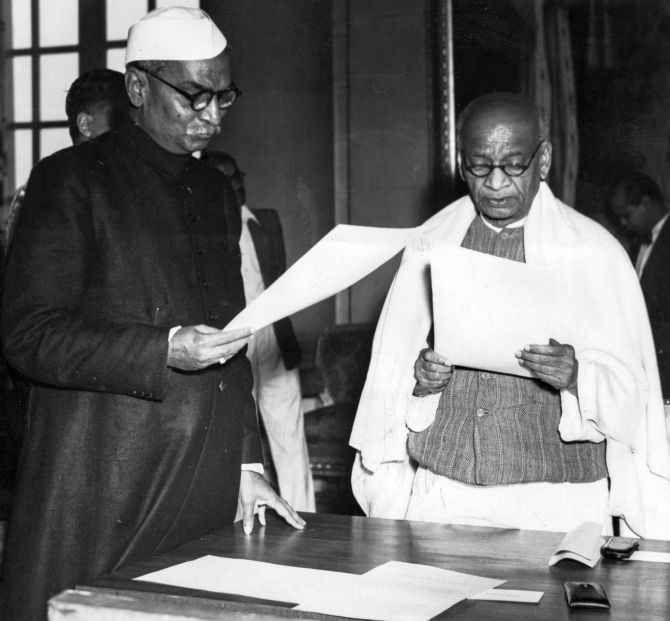Vallabhbhai Patel's great claim to fame originated from his steely leadership of a struggle against a repressive regime, a good three decades before the achievement of states unification, notes Shreekant Sambrani.

Vallabhbhai Patel, whose birth anniversary we observe with much pomp and circumstance, rose to national prominence 90 years ago through his sterling leadership of a seminal event in India's independence struggle, the Bardoli Satyagraha.
Unfortunately, it is reduced to a mere footnote, largely due to its marginalisation in the official history of the Indian National Congress released in 1985.
Dr Chittaranjan Desai, son of Patel's contemporary and great friend Dadubhai Desai (a descendant of Patel's collateral maternal family branch) has extensively documented it in his immaculately researched India's Struggle for Freedom, Three Strategies (2007, reissued in 2017).
Recapitulating salient features of this epic occurrence would be perhaps as fitting a tribute to the great man as erecting a monumental statue of him.
Mahatma Gandhi had set up the Sabarmati Ashram in Ahmedabad in 1917. Patel, who came to know Gandhi the previous year, came to Ahmedabad in 1917, becoming secretary to the Gujarat Sabha of which Gandhiji was the president. He also became a municipal councillor.
Gandhiji launched the Kheda Satyagraha in 1918. He was mostly away in Champaran and Patel had to shoulder the responsibility since he hailed from Kheda. That activity fizzled out for lack of preparation and unclear focus.
Bardoli was a taluka town in Surat district in south Gujarat (now the headquarter of the Tapi district). It comprised 137 villages in the rich farm and pasturelands of the Tapi valley.
The Bombay presidency government surveyed the taluka to settle rates of revenue. Two committees concluded that the area and the farmers had prospered and recommended a 30 per cent rate increase (later reduced to 22 per cent).
The government hastily accepted this and announced the new rates to be effective from July 1927 in contravention of the practice of a year's waiting. Farmers were agitated and Dadubhai Desai, who led a seven-member group of legislative councillors, decided to start an agitation on their behalf.
For a start, the group resigned their seats.
Desai found support, but felt that the agitation needed a more forceful leader. He requested Patel to assume the mantle.
Patel was reluctant, since he had his hands full as the president of the Ahmedabad municipality. After much persuasion and coaxing from Gandhiji, he agreed in February 1918. Shortly thereafter, he shifted base to Bardoli.
Farmers -- mostly anavils, vanias, and some Muslims as well as Parsis -- stood as one in their resolve not only to not pay the additional revenue, but also the regular rates. Only one village demurred.
The government was in no mood to listen. It employed dire measures including confiscation of farmer assets and cattle. It also sent police reinforcements and even Pathan mercenaries.
The Bombay governor, Sir Leslie Wilson, had the army stand by. Reports of entire villages emptying out, all establishments downing shutters and excesses of the police and Pathans gained wide currency.
The matter went up to Lord Irwin, the Viceroy, and Lord Birkenhead, the secretary of state for India, who had no option but to support the presidency government.
All concerned were alarmed at how rapidly the situation was getting out of hand.
Fearing the worst, the Desai group proposed a face-saving-formula: Farmers would pay the normal rate, Ramchandra Bhatt, a wealthy Bombay leader, would pay the additional 22 per cent, and the government would set up an inquiry committee immediately thereafter.
With some effort, all parties accepted this compromise and the government issued the notification in July 1918. This was universally hailed as a great victory for the Satyagraha and Patel personally, whom Gandhiji named Sardar (leader), a title he has been revered by thereafter.
The victory remained pyrrhic though until a year later when the government rescinded the increase and released confiscated properties following the inquiry report.
The more important consequence was the emergence of Satyagraha as a most potent form of agitation. Lord Irwin likened it to a prairie fire and wrote to the king emperor in July 1928, 'I am afraid we are in for a difficult time which may bring quite serious trouble.'
Gandhiji's Salt March (1930) and the Quit India Movement (1942) were clear offshoots of the Bardoli Satyagraha. But the All-India Congress Committee commissioned five-volume compilation, A Centenary History of the Indian National Congress (1886-1985), edited by B N Pande and released by Rajiv Gandhi, dismisses this in just a few lines in volume II without mentioning Patel.
Motilal Nehru extolled the Satyagraha in his Congress presidential address in 1928. For the presidentship in 1929, Gandhiji was nominated by 10 provincial committees, Patel by five and Jawaharlal Nehru, three.
Gandhiji withdrew and supported the younger Nehru, then just 40. Patel became the Congress president in 1931. These facts are notable in light of the belated claims of the Congress on the Patel legacy.
Unintentionally perhaps, Nehru and Patel were seen as rivals as early as 1929, with Gandhiji consistently favouring Nehru.
Most pertinent for us all in these fraught times is the fact that Sardar's great claim to fame originated from his steely leadership of a struggle against a repressive regime, a good three decades before the achievement of states unification.
Shreekant Sambrani is an economist.











